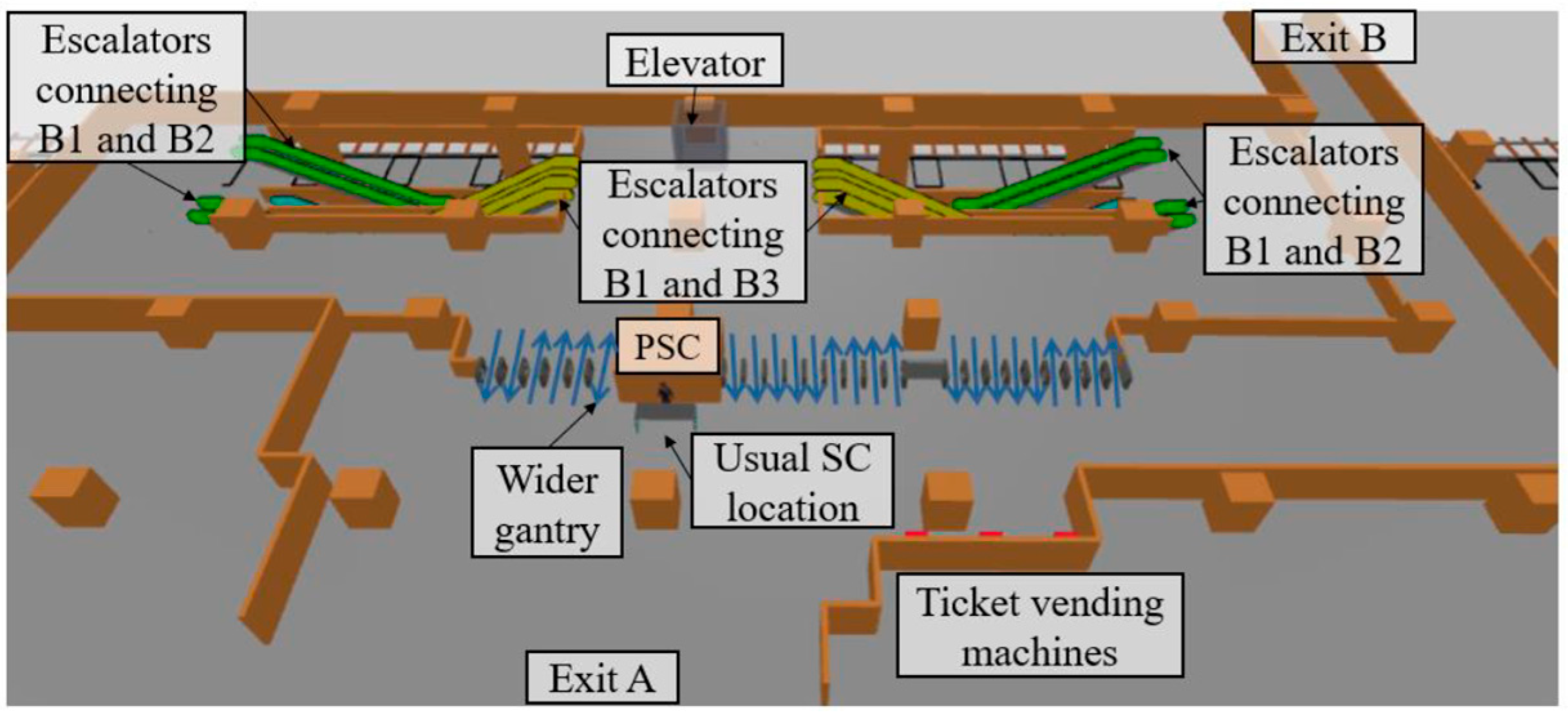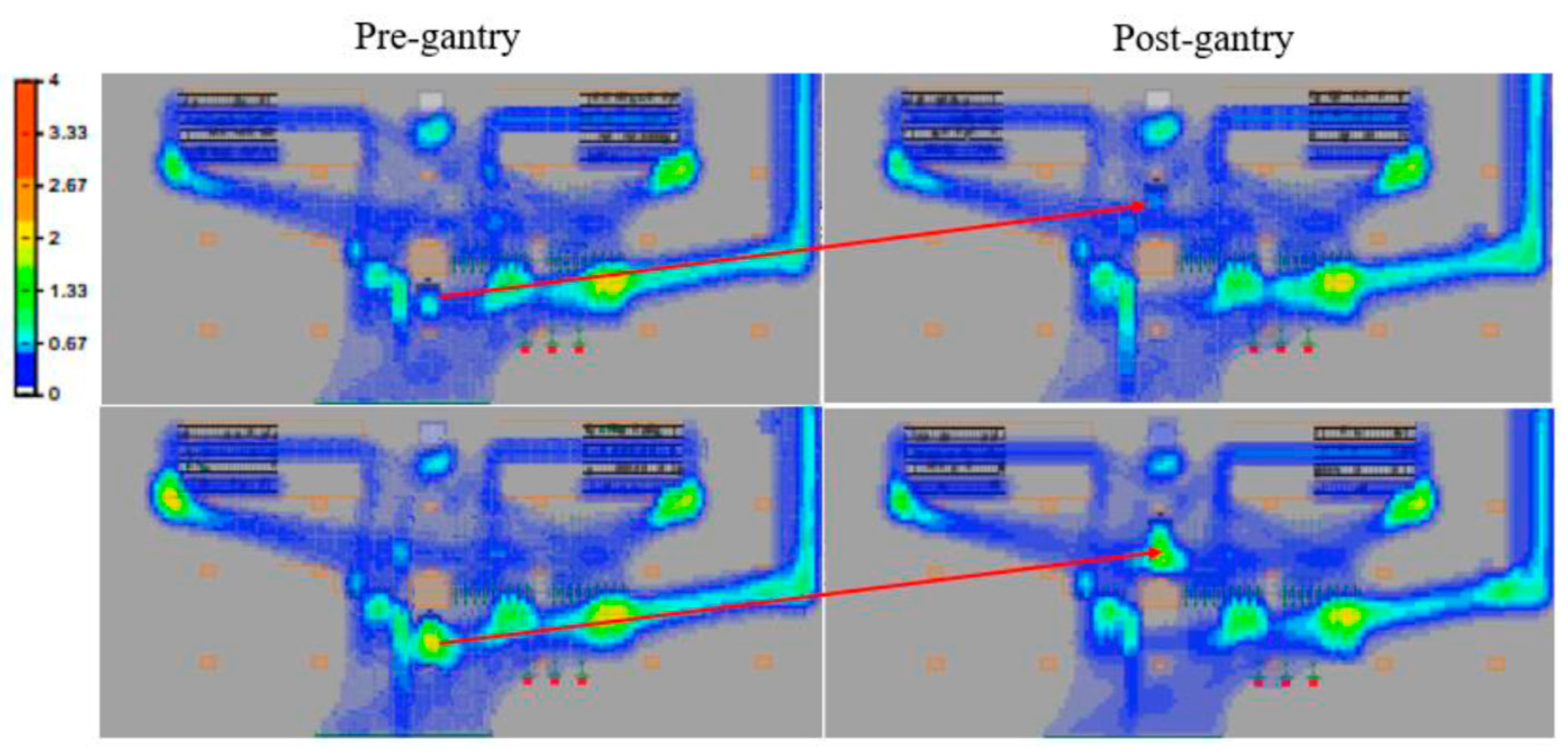Influence of Selective Security Check on Heterogeneous Passengers at Metro Stations †
Abstract
1. Introduction
- Comprehensive: All passengers need to go through door frame metal detectors and their bags need to be checked with handheld metal detectors or X-ray machines.
- Selective: Passengers are randomly checked at selected stations during regular emergency preparedness exercises, major events, or sometimes daily operation.
- Minimal: In this type, passengers are rarely checked upon entering metro stations, hence minimizing the impact on passenger flow.
- Most existing studies are conducted in mainland China under the comprehensive SC type. This might be difficult to directly reference for other places where an SC is not a norm, especially on how many passengers should be screened to avoid congestion.
- Since SC facilities in these studies tend to be bulky, the locations for SCs are usually fixed (at station entry points). There is one recent study [7] that considered moving SCs from the station hall to the entrance channel, which is sufficiently long for congestion prevention. However, this might not apply for stations without long entrance channels.
- Most studies only simulate inbound passengers or passenger flow near SCs. Only [7] has modelled alighting, boarding and transfer passengers when identifying bottlenecks.
- While some studies differentiate passenger profiles by luggage, the impact of such heterogeneity on their behaviours is considered only in the context of SC channel selection. More fine-grained behaviours such as passenger sizes, walking speeds and preferences for facilities in the stations were not modelled accordingly.
2. Methodology
2.1. Simulation Environment
2.2. Passenger Profiles and Behaviour Models
2.3. Experimental Design
3. Results and Discussion
3.1. Existing Bottlenecks with and Without SC
3.2. Influence of SC Percentage
3.3. Influence of SC Location
4. Conclusions
Author Contributions
Funding
Institutional Review Board Statement
Informed Consent Statement
Data Availability Statement
Conflicts of Interest
References
- Yu, H.; Wang, Y.; Wang, F.; Qiu, P. Understanding impacts of security check on passenger flow in a metro station and improving measures: A case study in Guangzhou, China. J. Adv. Transp. 2019, 1, 7438545. [Google Scholar] [CrossRef]
- Wei, Z.; Chu, S.; Huang, Z.; Qiu, S.; Zhao, Q. Optimization design of X-ray conveyer belt length for subway security check systems in Beijing, China. Sustainability 2020, 12, 2133. [Google Scholar] [CrossRef]
- Wei, Z.; Liang, J.; Qiu, S.; Wang, S.; Liu, S. How Many Facilities Are Needed? Evaluating Configurations of Subway Security Check Systems via a Hybrid Queueing Model. IEEE Trans. Intell. Transp. Syst. 2021, 23, 8209–8222. [Google Scholar] [CrossRef]
- Zhou, Y.; Zhao, M.; Sun, L. Optimization of bottleneck facilities in subway stations based on WiFi data. In CICTP 2019: Transportation in China—Connecting the World; Zhang, L., Ma, J., Liu, P., Zhang, G., Eds.; American Society of Civil Engineers: Reston, VA, USA, 2019; pp. 6287–6298. [Google Scholar]
- He, B.; Liu, Y.; Gao, X.; An, F.; Lv, X. Passenger Queuing Analysis Method of Security Inspection and Ticket-Checking Area without Archway Metal Detector in Metro Stations. Promet–Traffic Transp. 2023, 35, 772–785. [Google Scholar] [CrossRef]
- Wan, M.; Chen, Z.; Guo, J.; Wan, P. Optimization of security check efficiency in subway station based on Anylogic: A case study of Nanchang Metro. J. Intell. Fuzzy Syst. 2024, 41, 5035–5043. [Google Scholar] [CrossRef]
- Peng, J.; Wei, Z.; Li, J.; Guo, X.; Wang, S. Passenger flow bottleneck decongestion in subway stations: A simulation study. Simulation 2024, 100, 981–995. [Google Scholar] [CrossRef]
- E, J.; Li, M.; Huang, J. CrowdAtlas: Estimating crowd distribution within the urban rail transit system. In Proceedings of the 2021 IEEE 37th International Conference on Data Engineering (ICDE), Chania, Greece, 19–22 April 2021; pp. 2219–2224. [Google Scholar]
- Yeo, S.K.; He, Y. Commuter characteristics in mass rapid transit stations in Singapore. Fire Saf. J. 2009, 44, 183–191. [Google Scholar] [CrossRef]
- Lei, W.; Li, A.; Gao, R.; Hao, X.; Deng, B. Simulation of pedestrian crowds’ evacuation in a huge transit terminal subway station. Phys. A Stat. Mech. Its Appl. 2012, 391, 5355–5365. [Google Scholar] [CrossRef]
- Sonenblum, S.E.; Sprigle, S.; Lopez, R.A. Manual wheelchair use: Bouts of mobility in everyday life. Rehabil. Res. Pract. 2012, 2012, 753165. [Google Scholar] [CrossRef] [PubMed]
- An Inclusive Public Transport System. Available online: https://www.lta.gov.sg/content/ltagov/en/getting_around/public_transport/a_better_public_transport_experience/an_inclusive_public_transport_system.html (accessed on 15 January 2025).
- Ali, M.F.M.; Abustan, M.S.; Talib, S.H.A.; Abustan, I.; Abd Rahman, N.; Gotoh, H. A case study on the walking speed of pedestrian at the bus terminal area. In Proceedings of the E3S Web of Conferences, Penang, Malaysia, 28–29 November 2017; pp. 1–7. [Google Scholar]
- Davis, D.G.; Braaksma, J.P. Adjusting for luggage-laden pedestrians in airport terminals. Transp. Res. Part A Gen. 1988, 22, 375–388. [Google Scholar] [CrossRef]





| Profile | Comfortable Speed (m/s) | Diameter (m) | |
|---|---|---|---|
| 1 | Adults without luggage | ~N (1.27, 0.14) | ~U (0.44, 0.58) |
| 2 | Adults with luggage | × (1–30%) | + 0.17 |
| 3 | Elders without luggage | ~N (1.04, 0.21) | ~U (0.46,0.54) |
| 4 | Elders with luggage | × (1–30%) | + 0.17 |
| 5 | Children without luggage | ~N (1.08, 0.23) | ~U (0.39, 0.45) |
| 6 | Children with luggage | × (1–30%) | + 0.17 |
| 7 | PMD users | ~N (0.48, 0.21) | 1.2 |
Disclaimer/Publisher’s Note: The statements, opinions and data contained in all publications are solely those of the individual author(s) and contributor(s) and not of MDPI and/or the editor(s). MDPI and/or the editor(s) disclaim responsibility for any injury to people or property resulting from any ideas, methods, instructions or products referred to in the content. |
© 2025 by the authors. Licensee MDPI, Basel, Switzerland. This article is an open access article distributed under the terms and conditions of the Creative Commons Attribution (CC BY) license (https://creativecommons.org/licenses/by/4.0/).
Share and Cite
Mo, Z.; Zafir, M.; Bahoy, G.L. Influence of Selective Security Check on Heterogeneous Passengers at Metro Stations. Eng. Proc. 2025, 102, 3. https://doi.org/10.3390/engproc2025102003
Mo Z, Zafir M, Bahoy GL. Influence of Selective Security Check on Heterogeneous Passengers at Metro Stations. Engineering Proceedings. 2025; 102(1):3. https://doi.org/10.3390/engproc2025102003
Chicago/Turabian StyleMo, Zhou, Maricar Zafir, and Gueta Lounell Bahoy. 2025. "Influence of Selective Security Check on Heterogeneous Passengers at Metro Stations" Engineering Proceedings 102, no. 1: 3. https://doi.org/10.3390/engproc2025102003
APA StyleMo, Z., Zafir, M., & Bahoy, G. L. (2025). Influence of Selective Security Check on Heterogeneous Passengers at Metro Stations. Engineering Proceedings, 102(1), 3. https://doi.org/10.3390/engproc2025102003






